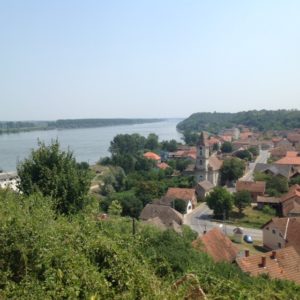Atya castle

Atya (Sarengrad) is a village in Croatia, in the historical area of the Szerémség. It is on the right side of the Danube River, 8 km from Újlak. The name „Sarengrad“ stands for the „castle of the Szár family“. The Hungarians call its castle “Atyavár”. There is a settlement called Voćin (Athyna), too.

The place was first mentioned in 1275 as a domain. Its castle was built in the middle of the 14th century by the Comes of Nyitra, Szár László and it guarded the crossing place on the Danube. It belonged to the Szár (aka Atyai, Kükei, Vér) family which was related to the Anjard clan who appointed its castellans before 1403. (Please, note that I use the Oriental name order for Hungarians where family names come first.) Later, the Hungarian king dispelled the Kükei family from the owners because they were not loyal. King Zsigmond gave it to Bán (Duke) Maróti János in 1398. It is thought that Lord Maróti was the one who carried out major construction work in the castle.
The Maróti family ceased to exist after 1476 so the castle frequently changed owners. At that time, the castle had 24 villages attached to it. In 1481, it was mentioned as an agricultural town. Maróti Mátyás was the last member of the family so Atya castle was inherited by King Matthias Corvinus. He gave it to Geréb Mátyás and Péter of Vingárt in 1481.
They were mentioned as the castle’s owners even in the 16th century. Geréb László, Archbishop of Kalocsa, died in his village called Teleki which was not very far from Atya castle and he was buried in the monastery that used to stand at Atya in 1507. The Saint Spirit (Szentlélek) Monastery was a Franciscan one and it was active between 1404-1516.

The castle belonged to the Perényi family between 1504 and 1516, and then the Török family of Enying owned it. In the castle, we can discover the remains of a medieval hall that used to have such big windows that cannot be found in any contemporary castles. The Turks occupied the place in August 1526 but they didn’t use it as a castle. After this, we can hear its name mentioned as a ruin mainly in the letters of travelers or historians.
For example, the historian Verancsich wrote about it in 1553 when Karl Rym mentioned a small square-shaped castle on a hill, it was called Athya. According to Ungnád Dávid, the locals called the ruins of Athiavar “Otthin” in 1572. Schweiger Salamon also mentioned a small ruin of a castle and a church in “Voking”.

The Ottomans left the area only in 1686. Now, you can see only some walls and a tower that survived perilous times. When visiting Újlak, it is worth taking a trip to see the ruins of Atya castle.

Here is a short video about the castle:
https://www.youtube.com/watch?v=wzsBX20Jpsg

Dear Readers, I can only make this content available through small donations or by selling my books or T-shirts:
Please, feel free to support me with a coffee here:
You can check out my books on Amazon or Draft2Digital, they are available in hardcover, paperback, or ebook:
https://www.amazon.com/dp/198020490X or at https://books2read.com/b/boYd81

My work can also be followed and supported on Patreon: Become a Patron!http://Become a Patron!

[wpedon id=”9140″]

https://hungarianottomanwars.myspreadshop.com/all



